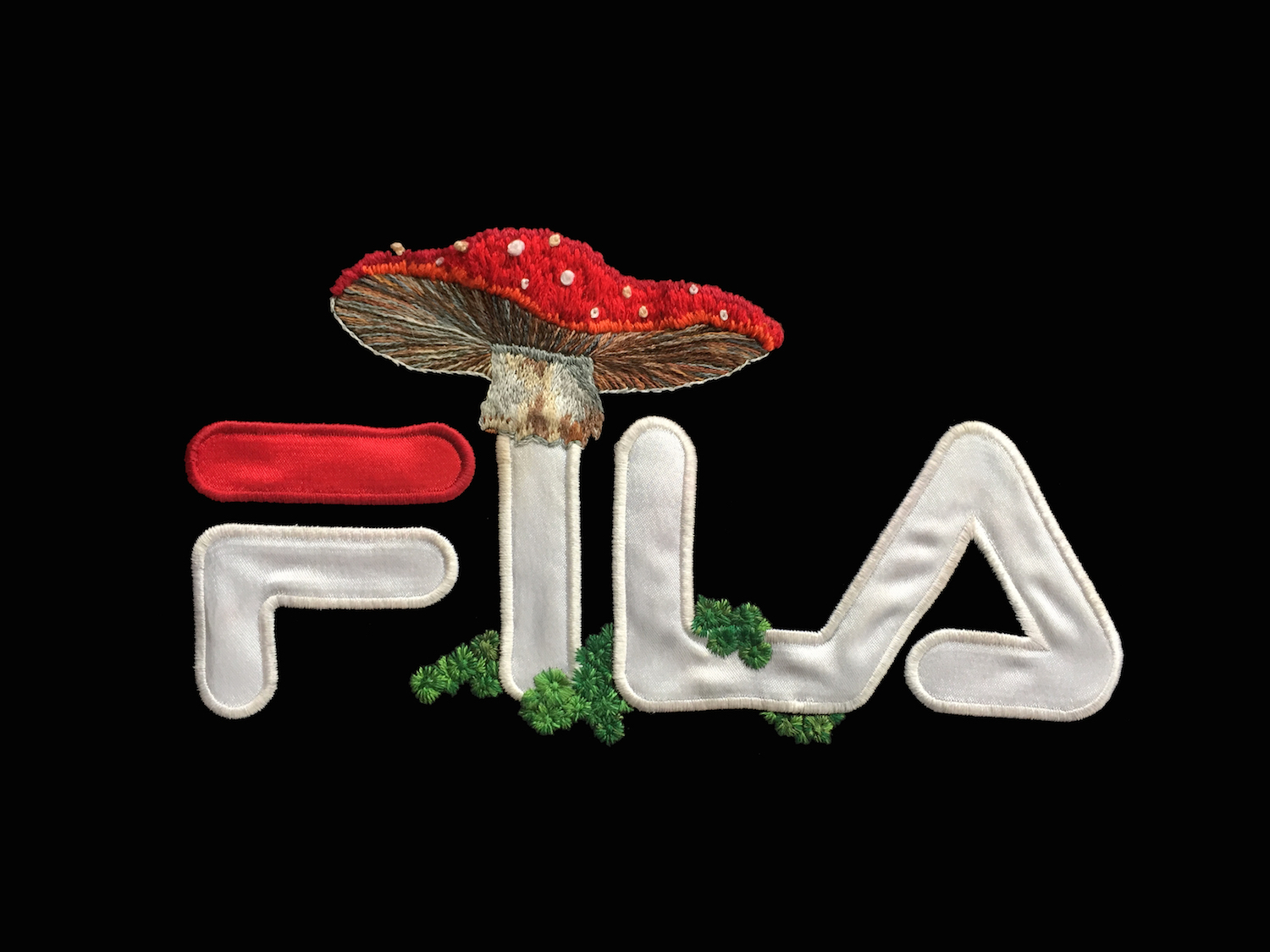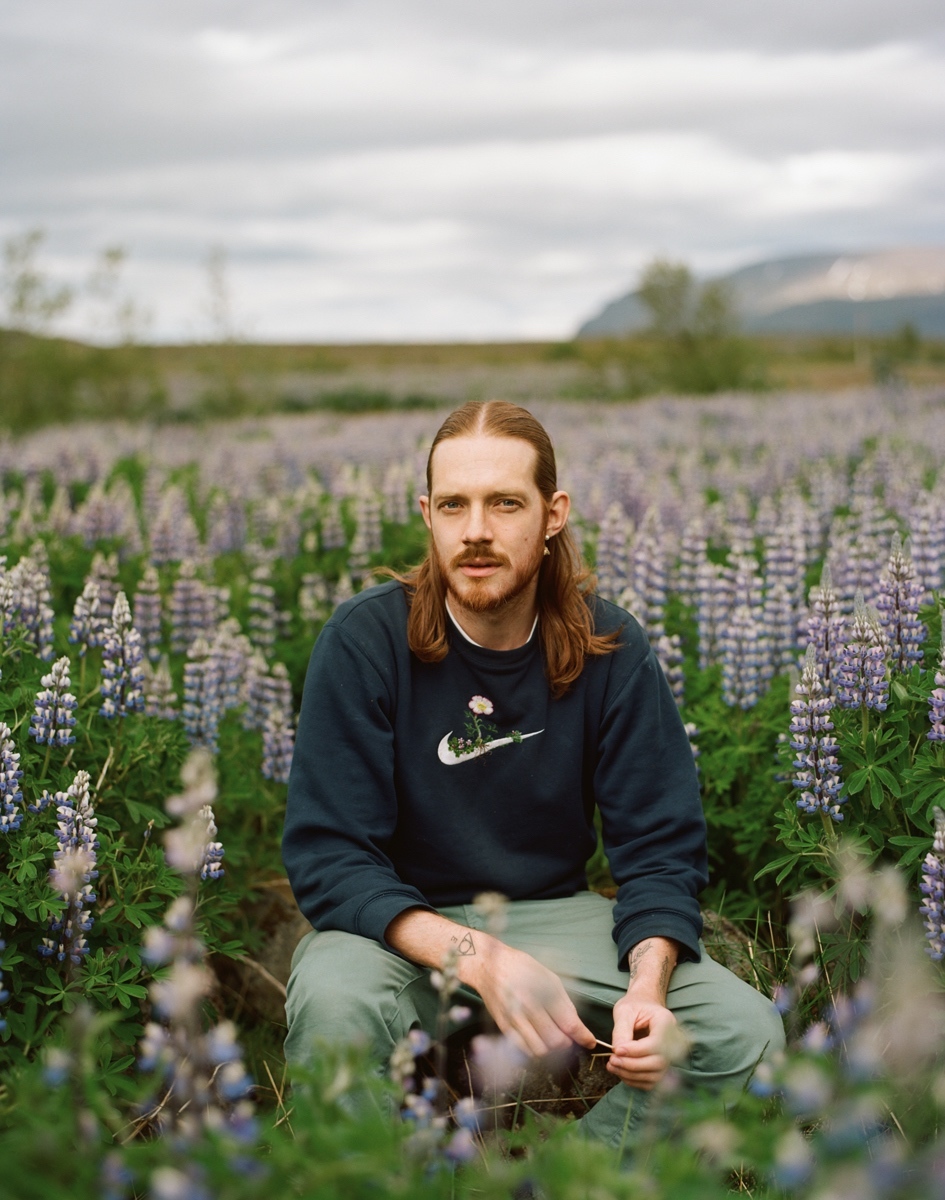Last month, when Björk performed at the Governors Ball Music Festival in New York, she fluttered across the stage in a glittering winged dress, accessorized with a bold and delicate lace headpiece by artist James Merry. James, who is based in New York and Iceland (where he lives in a cabin cocooned by lavender lupines), embroidered the black-and-white mask with swirls of neon and stitched in pearls. “Björk had a really specific set of references and shared images with me, including some of really gorgeous moths,” says James, who has been working with the artist for the past six years. “I loved their pronged fern-like white antennae most, so began embroidering those, and it slowly turned into some sort of techno-Victorian-moth mask.” Nature is an overarching theme in James’ personal work as well. In 2012, he released Anatomies, a book of illustrations fusing the shapes of plants with structures in human bodies, and he recently started to embroider flowers and fungi on classic sportswear (a flower and moss grows atop the swoosh of a Nike sweater, for example).

What do you love about embroidery?
I love the pace and focus and control of hand embroidery. It slows you down. It zooms you into a really precise point of focus, which can be very therapeutic if you have an otherwise quite large and busy life. And the portability of it—I can fit everything I need in my backpack and work on stuff while I’m on flights or watching TV. And then I love the wearability of the end product—they’re not stuck in a picture frame on a wall, you can wear them and bend them and put them in the washing machine when they get dirty. I love that aspect of it.
What is your favorite thing you have ever made?
I guess I’m always most excited by the last thing I made, which would be the lace headpiece for Björk to wear at a recent live show. I was a bit unsure if it was going to work while I was making it, but as soon as she put it on with the Nikoline Liv Andersen dress, it all came together so well and I was thrilled.

How did your partnership with Björk come to be?
I was introduced to Björk over 6 years ago through a mutual friend in London when she was just starting to conceive Biophilia and looking for an assistant to come on board. It was such an adventure. We swapped a few YouTube videos by email and then I went to meet her in New York. I went back to London, and then two weeks later, I dropped everything and moved out to New York to work with her full-time, which I’ve been doing ever since. I’ve always been a bit reluctant to talk about it really, as it has always existed in such a magical and fertile place and I would never want to burst that bubble by trying to define it too much. But meeting and working with her has definitely been the best thing that ever happened to me, in so many ways.
Prior to that, you worked with Damien Hirst. What did you do and what was that like?
At first, I was in his studio making the kaleidoscope butterfly paintings, but then I started doing more admin kind of stuff, partly because I had a knack for remembering all the butterfly names.

How did you come up with the idea for Anatomies?
I think a lot of it was an attempt to explain actual physical sensations I would feel when looking at plants or flowers—some kind of weird tactile/plant synesthesia. My fingers would tingle when I’d see small furry buds on the end of branches, or I’d feel flowers growing out of my eyes if I stared at them too long. I was fascinated by that overlap between botanical and anatomical. It’s always such a lush place, where two seemingly different worlds can overlap.

Where did the idea come from for your new sportswear series?
At the start of this year, I had been stuck in New York for a bit longer than I am usually comfortable with. I was really missing Iceland and being in the countryside, so I guess it was some kind of silent protest of mine—to take something that was super urban and machine-made and barren (my old Nike sweater), and fertilize it, forcing it to flower by embroidering a glacier flower and moss on it. I guess these embroideries are similar to the drawings in Anatomies, in that they both focus on a very particular point of transformation—the moment when one thing turns into something else. I’m obsessed with that.

What do you listen to while you’re working?
I always have to have music playing when I work. At the moment, I’m listening to a lot of Tinashe, as well as Arca and Tink. I’ve recently been listening to a playlist of Japanese electronic music on Soundcloud, called “Fairlights, Mallets and Bamboo.”

Where do you find inspiration?I think I’ve had most of my better ideas at the local swimming pool in Iceland. I also get a lot of inspiration from walking and camping and gardening here. Everything is so extreme, particularly the sense of scale: You can be in the shadow of an immense glacier, but on your knees in the moss, looking at a tiny stubborn arctic flower poking out of the lava rock, marveling at its tenacity.
Credits
Text Zio Baritaux
Portrait Thomas Whiteside
